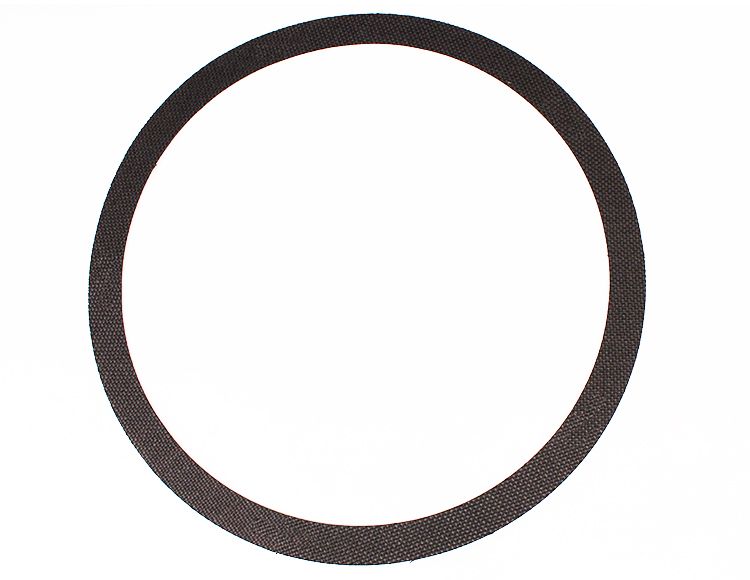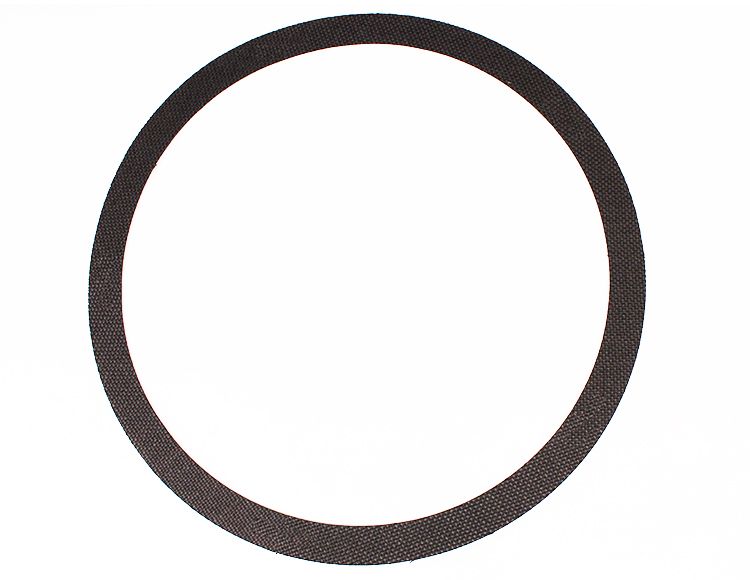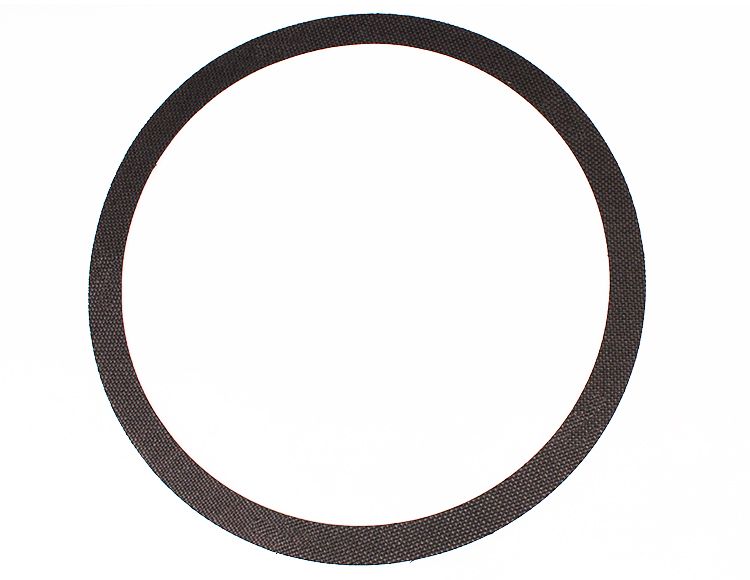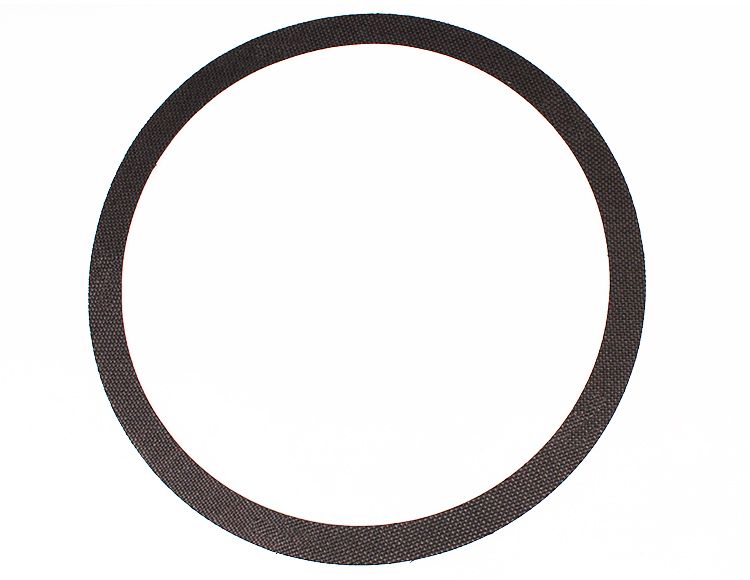2017年8月28日
Rebuilders Rally to Crack the Code: Converter Identification
Ed Lee
A torque converter is like a box of chocolates. You never know what you’re going to find. Until now.
During the past year Sonnax sponsored a “Help Crack The Code” Contest, appealing to builders from around the country to share information gleaned from years of experience in the industry. Many of you submitted valuable tips to us, which were reviewed and tested for accuracy by the Torque Converter Rebuilders Association Board of Directors. Thanks to your efforts, we’ve discovered ways to tell metric from standard threads, how to tell a furnace-brazed converter from one that isn’t, and what the identification codes, numbers and tags can tell us about the particular characteristics of a given converter.
公制与标准
Do you know how to tell the difference between a GM400-styleconverter with metric threads in the mounting pads from one with standard threads – without checking the threads? We didn’t either, but Gary Rogers at Robert T. Holt & Sons in Mount Pleasant, Texas, showed us how.
 |
 |
His secret (also GM’s secret for many years) is this: There’s an identification groove just above the welds that attach the mounting pads to the cover on all 400-style torque converters with metric threads. (SeeFigure 1)。具有标准线程的典型转换器将如图所示Figure 2.
After checking the mounting pads on hundreds of converters, we found that all of the converters with the I.D. groove did, in fact, have metric threads. (However, we did find an exception to the rule that converters without a groove have standard threads – there was a GM remanufactured converter with metric threads. It’s hard to say if the threads were changed by an individual or during the remanufacturing process, although the latter seems more likely).
The information Gary has gleaned about the 400-style converters may well apply to other converter styles since GM tends to stick with processes once developed. His tip may help someone else solve yet another piece of the puzzle.
Furnace-brazed or Not?
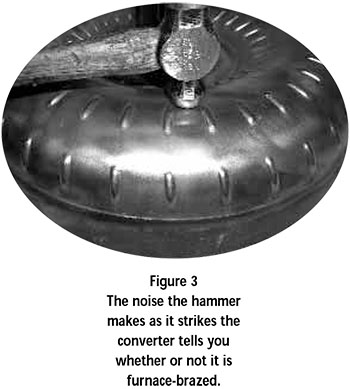
OE制造商是其炉膛钎焊机,以满足扭矩负荷需求的增加,并且能够识别它们是至关重要的。您可以使用旧的剪辑和外观方法,但通常耗时,随着炉钎焊的转换器的数量增加,所以有很快就能找到一个。
DACCO的最新目录包括一些方便的炉钎焊信息298mm.section. If you can see the I.D. code on your converter, the second digit will allow you to determine both the stall of the converter and whether it is furnace-brazed. This I.D. method works well on most late-model GM 298mm converters. It’s a good bet that if the second letter of the code is a C, H, K or L, your converter will have a furnace-brazed impeller. You may also notice that on the late-model 298mm converters, the majority of the I.D. stickers in a solid color will have a furnace-brazed impeller and the majority of the stickers with stripes won’t. Unfortunately, neither is foolproof enough to use as an identification process.
但“帮助打破代码”比赛的获奖者之一提供了缺失的链接。来自科罗拉多州科罗拉多州Collbbell的Jesse Campbell在科罗拉多州,声称他可以判断转炉是否是炉子钎焊,而不是用球喷丸锤击中时发出的声音。他是对的。
Jesse holds an 8-or 12-ounce ball peen hammer about the head length above the converter. Holding the handle loosely, he lets the hammer fall. The hammer strikes the converter between the two dimples, on the middle row of dimples, on the impeller side of the converter (seeFigure 3)。一个沉闷的声音告诉他转换器不是炉子钎焊。炉钎焊转换器有一个清洁,更锐化的响声。
不w,传播shops have been using this trick for years to tell if GM 700 pump rings were hardened or not. With a little bit of practice anyone can become proficient at finding the furnace-brazed core.
One word of caution:With the possible exception of some late-model FordAODE / 4R70W.converters, the Ford 12” impeller was never furnace-brazed. When you are mastering Jesse’s ball peen method, you’ll find some FordC6或者AOD转换器发出类似于炉子钎焊的叶轮的声音。您的听证会不是炉钎焊规则的例外,而是一种判断叶片在12“福特叶轮中的叶片的方法。一个带有良好的叶片的叶轮会发出一个沉闷的声音,就像你期望的那样。你不期望的是,叶片的叶片宽松,声音越相似,钎焊叶轮的声音就越多。这是一个双赢的情况。你不仅可以判断叶轮是否是炉子钎焊,你还可以说叶片的速度也有多紧。
 |
当TCRA董事会的一些成员正在测试Jesse的方法时,Dacco唐兰多尔夫说,他可以判断298毫米的叶轮,只要通过看着它就是屏风。唐继续正确识别六个转换器中的六个。
Don explained that the vane helps strengthen the impeller. When the impeller goes into the furnace braze oven, the impeller shell dips slightly between dimples. An impeller that has not been in an oven will be straight across between the dimples (see图4.and5)。

除了一个因素之外,这将是一个优秀的识别方式:很多I.邮票 - 也位于凹坑之间 - 倾向于弯曲盖子。这使得难以区分烤箱浸和弯曲块。但是,您可以确定在凹坑之间浸没的所有转换器都不会是炉子钎焊。
摩擦的问题
Every converter builder knows there are three different types of friction material to choose among: paper, carbon and woven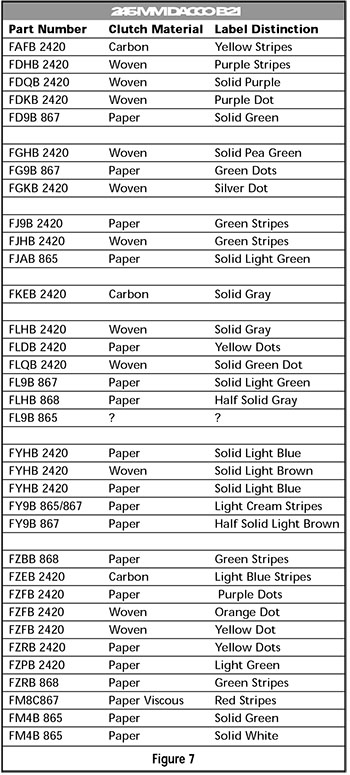 石墨。这些摩擦材料中的每一个都具有其独特的特性和特定用途,使能够识别每个应用所需的正确材料。但它并不容易。
石墨。这些摩擦材料中的每一个都具有其独特的特性和特定用途,使能够识别每个应用所需的正确材料。但它并不容易。
 石墨。这些摩擦材料中的每一个都具有其独特的特性和特定用途,使能够识别每个应用所需的正确材料。但它并不容易。
石墨。这些摩擦材料中的每一个都具有其独特的特性和特定用途,使能够识别每个应用所需的正确材料。但它并不容易。
通用汽车转换器哈ve proven particularly problematic. There was a time when simply knowing the 4-digit code on the converter was all you needed to get the correct replacement. Those days are gone. Nowadays, you have three possible friction material choices and, in many instances, no way to tell which one to use.
Jim Currier Jr. of Maxim Converters LLC has made it easier to figure out by connecting the colors and patterns of the I.D. stickers with the I.D. codes. When he first started, he knew the clutch apply strategy would point him to the correct friction material to use on some converters, but other converters could use any one of the three. This dilemma was especially problematic when it came to the245mmGM.B21, particularly on the FLHB converter.
Jim began to notice subtle differences in the colors and patterns of the colors on the I.D. stickers of converters with the same I.D. code. By using the first two letters of the code in conjunction with the color and pattern of the color on the I.D. tag, he was able to I.D. the friction material used in nearly all converters – until he found an FJ9B converter with green diagonal stripes with a paper lining, and a FJHB converter with green diagonal stripes with a woven graphite lining. At this point, he added the third and fourth digits of the code to his I.D. decoding process. He was soon able to say with certainty that a FYHB converter with a solid pattern/light blue tag would have paper friction material on the clutch and the same FYHB code with a solid pattern/light brown tag would have woven graphite friction material on the clutch (seeFigure 6)。Jim continues to have good success with this system today, provided the I.D. tag is present.
Five of the patterns for the late model B21 converters are listed here, along with the codes and colors and the friction material that they identify (seeFigure 7)。Please note that many of the early B21 patterns that were only used on the 125 lockup converters have been left out because they all had paper linings.
More Deciphering
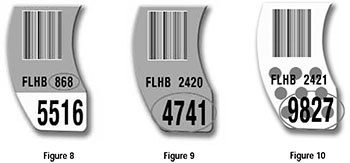
FLHB转换器也fo头痛不已r Jeff Lehmann and Bill Spratt at Precision Converters of Ohio. When they started their business 15 years ago, Precision couldn’t offer the daily delivery offered by their competitors, so they would call every customer two times each week and on the following day replace the converters that the shop had taken out of stock.
系统工作正常,只要传输储存正确识别正在更换的转换器即可。缺点是,如果转换器未正确识别,可能需要几天核心返回并削减正确识别。而这在用FLHB代码确定GM转换器上的正确摩擦材料方面尤为重要。
They knew there was a good chance that FLHB converters with the early part numbers (the seven-digit part number that started with 86) would have paper linings (seeFigure 8)。But any identification beyond the early paper was just a guess. In 1998 Jeff and Bill started noticing that all of the FLHB converters with the large four-digit number 4741 on the I.D. tag had woven graphite friction material on the clutch (seeFigure 9)。

这种加强对大型四位数字的认识允许它们识别第二个数字,该数字也仅在具有编织石墨衬里的转换器上发现。第二个数字是4742,它是在I.D的FYHB代码的转换器上找到。标签。很快他们已经扩大了他们的i.D.系统尽可能多地覆盖多个转换器。他们在系统上教育了客户,并将其通报了任何新信息。今天系统仍在使用中,并使顾客更好地了解顾客,您的问题越少。
Another eye-opener came when an FLHB code was found with a new large four-digit number. This new number was 9827 (seeFigure 10)。This converter was very similar to the FLHB converter with the 4741 number, except that it had a 21-vane stator. The converters with the FLHB code historically have a 14-vane stator. It’s very uncharacteristic for GM to use a different stator in a converter with the same code. The good news is that this FLHB converter with the 21-vane stator has a different large four-digit number. Is it possible that the stator can also be identified by this number? This information also raises questions about the identification of other components of the converter by the large four digit number.
经过大量研究和长时间,TCRA板已编制为填写列表,尽可能地了解了四位数数字的信息(参见Figure 11)。The list will undoubtedly continue to grow for some time.
 |
In the meantime, our thanks to Gary Rogers, Jesse Campbell, Jim Currier Jr., Jeff Lehmann and Bill Spratt for taking the time to do the research, and for sharing the knowledge they have learned. They wholeheartedly deserve to be the winners of the Sonnax “Help Break the Code” contest.
Ed Lee is a Sonnax Technical Specialist who writes on issues of interest to torque converter rebuilders. Sonnax supports thebob游戏怎么下载Torque Converter Rebuilders协会.
学到更多
Related Units
AOD(FIOD)转换器
C4, C6, FMX 12", C4 11-1/4" Converter
298mm Lu(250c,350c,200-4r,4l60&e)转换器
400(3L80),AT-540转换器
阳极,4R70W,4R75W转换器
Related Parts
Required
Recommended
280mm LU (4L60-E) “VJCX”,298mm.LU (250C, 350C, 200-4R, 4L60 & E),300mm (4L60-E)
Friction RingS20250WC.
- Material:厕所
- Outer Dia.:11.125"
- Inner Dia.:10.000“
- Thickness:0.020“
Required
Recommended
245mm LU Euro (5L40-E),258mm Lu(4L60-E,5L40-E),258mm lu(4t65-e),4L60-E (298mm), Single-Plate Performance Converter,4L60-E (300mm), Single-Plate Performance Converter,6L80 (300mm), Single-Plate Performance Converter
Friction RingS20300WC
- Material:厕所
- Outer Dia.:9.500"
- Inner Dia.:8.250"
- Thickness:0.020“
Required
Recommended
245mm LU(3T40,3L30,200C,4T60-E,4L60&E:S-10),4L60 (700-R4), 4L60-E, 200-4R (298mm) Single Plate Performance Converter (Mounting Ring),4L60-E(300mm),单板性能转换器(安装环),4L80-E, 4L85-E, Single-Plate Performance Converter (Mounting Ring),AODE, 4R70W Performance Converter
Friction RingS20320WC.
- Material:厕所
- Outer Dia.:9.000"
- Inner Dia.:7.750“
- Thickness:0.020“
Required
Recommended
6T40 / 6T45,236mm
Friction RingS20680WC
- Material:厕所
- Outer Dia.:9.813"
- Inner Dia.:8.562“
- Thickness:0.020“
Required
Recommended
6L80, 6L90 (300mm)
Friction RingS20750WC
- Material:厕所
- Outer Dia.:11.120“
- Inner Dia.:9.840"
- Thickness:0.020“
Required
Recommended
6F50/6F55,6T70/6T75
Friction RingS20930WC
- Material:厕所
- Outer Dia.:10.200"
- Inner Dia.:9.200“
- Thickness:0.020“
Required
Recommended
虽然Sonnax尽一切努力确保在出版时确保技术文章的准确性,但我们对不准确或可能过时或过时的信息不承担任何责任。
